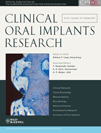Assessment of mini-implant displacement using cone beam computed tomography
Abstract
Objectives: To assess, through cone beam computed tomography (CBCT), the mini-implants' stability and behaviour when submitted to orthodontic force during upper molars' intrusion.
Material and methods: Forty-one mini-implants were divided into two groups: 30 in the buccal and palatal mini-implants group (BPMI), inserted into buccal and palatal sides, and 11 in the midpalatal mini-implants group (MPMI), inserted into midpalatal suture. One day after insertion, a 200 gf was applied on the mini-implants during a 5-month period. CBCT was performed twice: before force application (CBCT 1) and 5 months later (CBCT 2). For mini-implant displacement assessment, the distance of mini-implants' head (HMI) and tail (TMI) to coronal, sagittal and axial planes was measured at CBCT 1 and 2.
Results: For the BPMI group, the displacement rate was statistically significant (P<0.05) in all three dimensions for both the head and the tail. For the MPMI group, the displacement rate was statistically significant (P<0.05) only in the antero-posterior (head and tail) and vertical (head) dimensions.
Conclusions: Buccal, palatal and midpalatal mini-implants showed some displacement (mean value ≤0.78) when submitted to force, although they are aimed to provide stable skeletal anchorage.
To cite this article: Alves M Jr, Baratieri C, Nojima LI. Assessment of mini-implant displacement using cone beam computed tomography.Clin. Oral Impl. Res. 22, 2011; 1151–1156.doi: 10.1111/j.1600-0501.2010.02092.x




